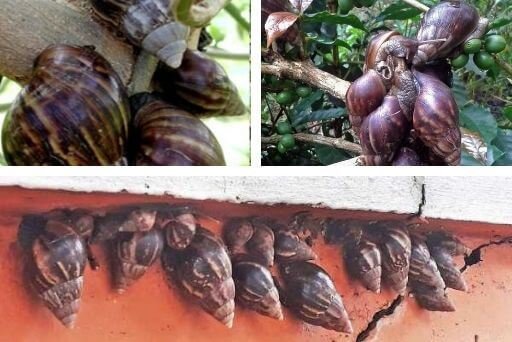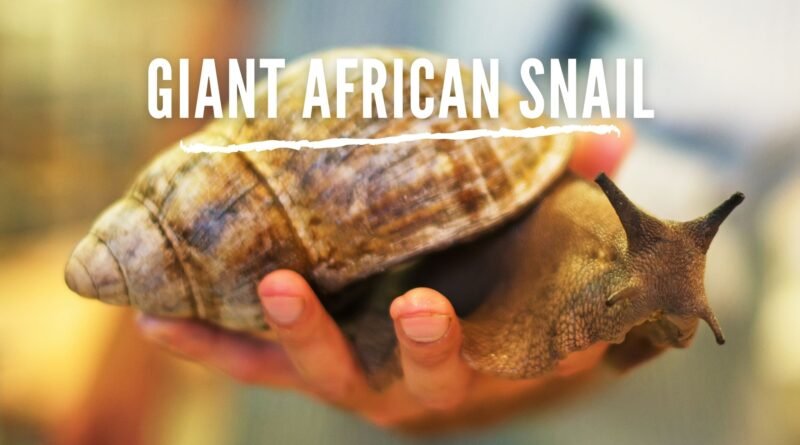Giant african snail is a serious threat to agriculture, biodiversity, and human health
The giant African snail (Achatina fulica) is believed to be the most widely distributed invasive, adaptable pest land snail.
Scientists say, “Giant African snails aren’t only a threat to agriculture, ecology, and economy but also pose a threat to human health”.
These bornless and sluggish creatures have become popular as pets over the last few decades. Especially in Europe, people consider snails as easy-going pets for children and old people. Snails are nocturnal herbivores that feed on almost 500 species of plants and crops including most varieties of beans, cucumbers, melons, peanuts, and peas.
Though GALS look highly adorable and calm as pets, they’re insanely invasive and threatening to agriculture, biodiversity, and human health. Even the United States Department of Agriculture (USDA) has commanded against owning or shipping giant African land snails.

Why giant african snail is a threat?
Raut and Barker in their book, Molluscs as crop pests, 2002, put insight into the origin, feeding behavior, and reproduction of giant African land snails as garden and agricultural pests. The authors also highlighted the preventive measurements for the control of these frighteningly invasive species of snails. Raut and Barker also summarized how the species of giant African land snails distributed around the globe.
Giant African land snails are native to Africa and were accidentally distributed across the globe (except for Antarctica) in the 18th century. The existence of a giant African land snail began in the United States of America back in the 1940s. After getting accidentally introduced to the United States, giant African snails insanely grew in number with their unique reproductive process.
Scientists say, “A big part of the threat the GALS poses is its capability to reproduce thousands of offsprings annually”.
GALS is a hermaphrodite meaning it has both male and female sex organs. These invasive creatures can lay approximately 1,200 eggs annually. Compared to other small animals, giant African land snails have a relatively long lifespan. GALS can live up to 10 years with desirable environmental conditions and sufficient food availability.
Back in the 1960s, a Floridian boy bought three vulnerable looking giant African land snails from his tour to Hawaii. Later his grandmother let the three happy-go-lucky snails roam in her garden. In just seven years, the population of giant African land snails in Florida increased dramatically (more than 18,000). Later in 1973, the government of Florida spent approximately one million dollars and a decade to annihilate these garden and agricultural pests.

Albert R. Mead in his book extensively reviewed the eradication of giant African snails in Florida after its dramatic increase. Mead is an American malacologist. The eradication involved hand collecting, public awareness measures, and the use of molluscicides.
Mead stated, “If the giant African snails were not eradicated timely, the agricultural losses would have been in millions by the end of 2011”.
According to the United States Department of Agriculture (USDA), giant African land snails could cause severe damages to the crops and ecology of the soil. With a voracious appetite, giant African land snails can consume common vegetables, a wide range of ornamental flowers, and fruits. The appetite of this destructive species can gravely damage crops at an alarming rate.
In addition to agricultural damages, giant African land snails pose threat to biodiversity and human health as well. Giant African land snails transmit or introduce pathogens or other infectious bacteria in humans causing mild or severe health issues. Giant African land snails act as a natural intermediate host of metastrongyloid lungworms. GALS also carry Aelurostrongylus abstrusus, Phasmarhabditis hermaphrodita, Rhabditis sp, and Strongyluris sp.
Scientists say, “Giant African land snails are vectors of a parasite that causes meningitis (inflammation of the meninges) in neonates and adult humans”.
In 2013, Robert H. Cowie discovered that giant African land snails transmit rat lungworm (Angiostrongylus cantonensis) in humans. Cowie is a research professor at Pacific Biosciences Research Center, University of Hawai’i, Honolulu, Hawai’i, USA. Angiostrongylus cantonensis is the chief culprit that causes Eosinophilic meningitis in humans and animals.
Meningitis is a life-threatening disease; it can cause the patient to experience nausea, headache, fever, and a stiff neck. 1 out of 10 meningitis patients don’t survive. Even survived patients may suffer from brain damage, disability, rapid hearing loss, or seizures.
Alicata (1991) and Carvalho (2013) also discovered in their respective studies that giant African land snails transmit two zoonotic nematodes (Angiostrongylus costaricensis and Angiostrongylus cantonensis) in humans and animals. These parasitic nematodes could cause rat lungworm disease (eosinophilic meningoencephalitis) and abdominal angiostrongyliasis in humans.
Since 2011, USDA and FDACS are cooperatively running a regulatory program to completely eradicate this voracious species from the US. The government of the United State has reportedly received information about the presence of this species in Miami, Hawaii, and Florida. The government spends approximately 2 to 3 millions dollar per year on the regulatory program and surveys.

Conclusion:
Giant African land snails, after being introduced in different tropical and subtropical regions, have gravely threatened agriculture, transmitted various parasitic nematodes in humans, caused severe health issues, inflicted large economic costs, and disturbed the natural ecosystem structure. Such catastrophic risks explain why giant African snails pose a serious threat to agriculture, biodiversity, and human health





